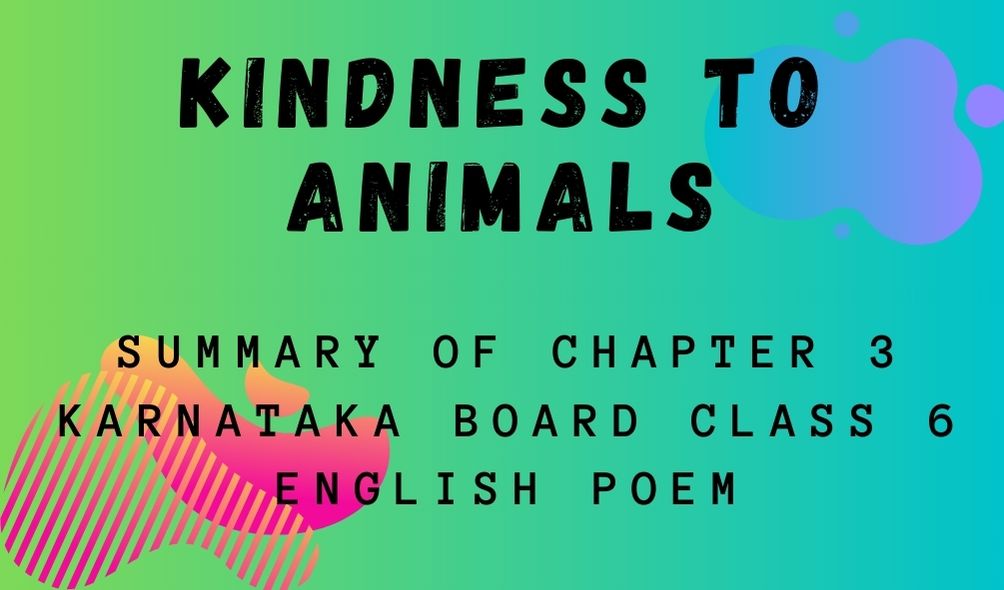You are going to go through the Summary of KINDNESS TO ANIMALS Chapter 3 Karnataka Board Class 6 English Poem. Understanding a story meticulously in its entirety is very important for a learner for scoring better in the exam. Experts made every effort to ensure a thorough and proper summary of the story. Let us find the Summary of KINDNESS TO ANIMALS Chapter 3 Karnataka Board Class 6 English Poem.

About the poem:
This poem is about how we should show love and kindness to all animals around us. The title of the poem is enough to make it clear. The poet has said how happy the animals if we can assure them an environment where they can move freely without any sense of fear of getting hurt. The poet has also given instances of how we should be treating animals. It is very cruel to hurt animals in any way.
Structure of the poem:
Kindness To Animals
“Little children, never give
Pain to things that feel and live!
Let the gentle robin come
For the crumbs you save at home;
As his meat you throw along
He’ll repay you with a song.
Never hurt the timid hare
Peeping from her green grass lair;
Let her come and sport and play
On the lawn at close of day.
Summary of KINDNESS TO ANIMALS Chapter 3 Karnataka Board Class 6 English Poem
The little lark goes soaring high
To the bright windows of the sky;
Singing as if ’twere always spring,
And fluttering on an untired wing –
Oh! Let him sing his happy song,
Nor do these gentle creatures wrong.”
There is a specific rhyming pattern. It is AABBCC and so on.
Line by line analysis of the poem:
Lines 1- 2:
“Little children, never give
Pain to things that feel and live!”
According to the poet, children never hurt animals intentionally. That’s because of their pure heart. Children have compassion for anything that is living and has feelings.
Lines 3- 6:
“Let the gentle robin come
For the crumbs you save at home;
As his meat you throw along
He’ll repay you with a song.”
The poet wants everybody to be a compassionate as the children towards all living beings including the animals. When the gentle robin comes, we can just serve it the crumbs. This act of kindness is enough to make the robin happy and make it repay us with a nice happy song.
Lines 7- 10:
“Never hurt the timid hare
Peeping from her green grass lair;
Let her come and sport and play
On the lawn at close of day.”
Summary of KINDNESS TO ANIMALS Chapter 3 Karnataka Board Class 6 English Poem
The poet here says that we should never hurt the fearful hare. The hare is said to be peeping from the green grass, where it has its hiding place. We should let it play happily in the open without the fear of getting hurt. Without any worries, it should be able to play in the open and on the law by the end of the day.
Lines 11- 14:
“The little lark goes soaring high
To the bright windows of the sky;
Singing as if ’twere always spring,
And fluttering on an untired wing-”
The little lark is flying high in the sky with its untired wings. It is flying and singing as if it is always spring. The happy songs sung by the lark makes us feel that it is always spring around us.
Lines 15- 16:
“Oh! Let him sing his happy song,
Nor do these gentle creatures wrong.”
The poet has asked the readers to never cause any harm to these innocent creatures. They did no wrong, so we should not hurt them as well. they should be able to sing their happy notes and live their life.
Summary of KINDNESS TO ANIMALS Chapter 3 Karnataka Board Class 6 English Poem
Figures of speech used in the poem:
Alliteration: This is a figure of speech where closely associated words or corresponding words begin with the same alphabet in a sentence.
“Never hurt the timid hare”
